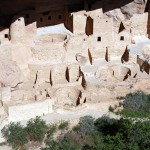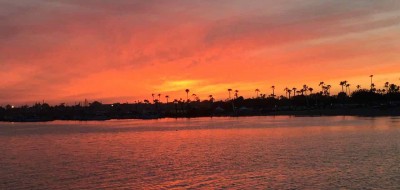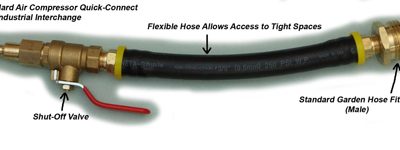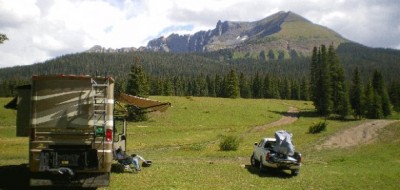By Bob Difley
 When was the last time you thought about water? We Americans and Canadians are so used to hooking up the hose to any available tap and filling our water tanks with pure, clean water that we don’t let bugs like typhoid, diarrhea, pathogenic microorganisms, and intestinal parasites to even enter our consciousness. And that sometimes causes us to become careless.
When was the last time you thought about water? We Americans and Canadians are so used to hooking up the hose to any available tap and filling our water tanks with pure, clean water that we don’t let bugs like typhoid, diarrhea, pathogenic microorganisms, and intestinal parasites to even enter our consciousness. And that sometimes causes us to become careless.
You may not drink plain, un-enhanced water, preferring wine, beer, coffee, sodas, or tea for your liquid intake. As explorer Owen Lattimore noted while traveling the ancient Asian Silk Road in camel caravans, “Water alone, unboiled, is never drunk. There is a superstition that it causes blisters on the feet.” But if water for any use–ice cubes, washing vegetables, brushing teeth–comes in contact with your insides, you might want to consider these extra firewall protections between you and the microscopic creepy crawlies.
• Fill your water tank only from water supplies that are confirmed “potable” (drinking) sources, such as from municipal, campground, and tested well water supplies.
• Every six months sanitize your tank by pouring in one-quarter cup of bleach for every 15 gallons of water in a full tank. Let stand overnight. Drain, fill, and rinse at least twice, or until chlorine odor is gone. Better yet, fill with water and bleach when leaving your last campground and let it slosh around in the tank as you head home.
• Be especially careful to keep the ends of your water hose out of the dirt and off the ground when attaching your host to a tap.
• Attach the ends together after emptying it of all remaining water and store coiled in a plastic or cloth bag.
• When possible, use your own water hose to fill your tank. You don’t know how previous RVers have handled the supplied hose.
• Do not fill your water tank from the water supplied at a dump station for rinsing down, unless you are sure it is a safe (municipal) water supply and you use your own hose.
• Wash your hands after using a dump station before using the water hose to fill your fresh water tank.
• Filter the water coming out of your kitchen faucet either with an under-sink inline filter (such as an Everpure) or attach a water filter (i.e.Brita) to your kitchen faucet. You can also keep a Brita-type pitcher of water with built in filter in your frig. These filters will also remove grit and bad tastes like you get from some desert water supplies.
• If you use the pitcher, remember to use the filtered water for washing veggies, making coffee, tea, cold drinks, and ice cubes, and if you’re slightly nervous about your current water tank supply, for brushing teeth as well.
Check out my website for more RVing tips and destinations and for my ebooks, BOONDOCKING: Finding the Perfect Campsite on America’s Public Lands, Snowbird Guide to Boondocking in the Southwestern Deserts, and 111 Ways to Get the Biggest Bang out of your RV Lifestyle Dollar.






Water Tank Cleaning
There are some bacteria’s developed in the water tank that cannot be removed easily and cause several diseases. Legionella is one among them which developed in dirty water and it causes lung infection in humans as it enters in the human body through air. Water tank cleaning services use some type of chemicals that destroy these insects.
Rod Mann
Giardia lamblia AKA Beaver Fever cysts are resistant to conventional water treatment methods such as chlorination and ozonolysis…
Cryptosporidium parvum is considered to be the most important waterborne pathogen in developed countries. It is resistant to all practical levels of chlorination, surviving for 24hrs at 1000 mg/L free chlorine…
Boiling water or a NSF standard 53 filter rated for cysts is the best way to provide safe water. I have a factory installed Everpure ADC cartridge system for drinking water and tooth brushing…
Jim Hutt
Excellent comments! Thanks to all that continue contributing to this subject. I have lived and worked in two foreign countries, but I have learned things ‘a new’ for all the commints. I look forward to reading and learning more from the RV community on this subject.
LARRY DAMBA
WHEN TRAVELING IN RV WITH UNKNOWN PURITY OF WATER SOURCE, I RECOMMEND NOT PUTTING ANY ON YOUR FRESH TANK, BUT USE THE SOURCE PRESSURE. ALSO MICROWAVING ANY WATER USED FOR DRINKING OR FOOD PREPARATION WILL KILL MOST HARMFUL “BUGS”
Vicki Sherouse
We are currently RVing in Europe and Turkey. We carry a SteriPen which uses UV light to purify 1 liter of water in 1 minute. This goes a step further than any filter and actually kills all kinds of microbes. We use it for our drinking water whenever we have to fill from a dubious source. We also used it backpacking in the woods and on trips to China and Nepal. It saves the weight of bottled water and doesn’t contribute to plastic water bottle pollution.
Liz Bard
When you empty the fresh water with bleach, do you do it by dumping into the black water and grey water? If you use one of the black water additives, is it ok with the bleach water? What is the best way to empty this bleach water?
Jim G
Vinegar (acetic acid) would NOT be a suitable substitute for disinfecting hose lines, etc.. I offer this response based upon 32 years in the public health profession.
Jim Hutt
Great article concerning a VERY important subject. I have been very sick on several occassion by drinking BAD water. What about using white vinegar to disenfect the hose connections in stead of bleach? The medical profession often uses vinegar as a disenfectant. Normally water the adjacent tree with park water before connecting to the RV, this is a way of purging the water hose of undesirables.
Geoffrey Pruett
Had the water quality issue pounded home on a move from Washington state to Texas. Noticed that the coffee tasted funny and put it to the strange smells that constant warm bring. Then tried the tap water without ice, Yukkk. Reasoned it out by looking at the map. Everything is uphill from Texas and most major cities use the same process, pull water from lakes, rivers or the ground and use it then process it to current standards and pour it back into the ground downstream. Sooner or later there are more things added to the water than can be removed by present methods. Small wonder that a new type of flu in Canada shows up in Dallas in a few weeks. Campgrounds tend to be away from city water supplies so to play safe we fill with bottled water. Adding a pump allows filling from a 5 gallon jug without back strain.
Jim G
A gallon of bleach $3.00 vs. the cost for an ER visit, tests and prescriptions at least $3,000. That is preventive medicine with a cost effective, common sense approach.
Jon
Good article and nice tips from others..you can’t be too safe with your drinking water.
tony
how do you get to the tank to add anything?
Ralph Z
how about using that water purifier (taste pure) I like to keep 1/4 tank while traveling just in case we stop at a wal mart for a night and also has come in handy when park supply froze.we had water till the thaw ( – ; thanx
cdude
I carry a spray bottle of 10% bleach to spray the camp ground water faucet before connecting my water hose. Have seen a lot of very unsanitary practices by some rv”ers who handle the water faucet after disconnecting their sewer hose or even running water into the sewer hose which comes in contact with the faucet. Just another precaution.
butterbean carpenter
Howdy Bob,
What about the weight of the tank of water, while on the road? We have been told
“don’t travel with a full water tank, because it costs you money…”
J5MM
Thank you so much for this great article! We will have to try the route of adding the bleach before departing our camp site. The road vibrations, I would imagine, would really do a good job in sloshing around the water. Thank you again!!